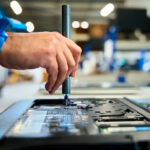IT purchase: what’s the difference between used and refurbished?
Most businesses allocate a significant budget for purchasing IT equipment. To optimise this expenditure, professionals are increasingly turning to used or refurbished hardware. However, these terms are not interchangeable. As highlighted by industry standards, the difference between used and refurbished equipment largely lies in the testing applied to refurbished items. As refurbishers ourselves, we can confirm that the distinctions go beyond that. Here’s a detailed explanation!
Refurbished vs used equipment
Refurbished equipment is defined as a used product that has undergone testing to ensure its functionality and safety. The refurbished category includes thorough assessments to ensure that the equipment is fully operational and secure.
Features of refurbished equipment
Refurbished equipment involves technical interventions that are not typically applied to used items. These interventions might include repairs, replacement of parts or minor components, and cosmetic refurbishing. For example, our refurbished equipment often benefits from new batteries, screen replacements, or even plastic refinishing. We also perform software updates.
For mobile devices (smartphones, tablets, laptops), refurbished equipment is often graded. These grades indicate the product’s condition and range from A to C:
- Grade A+: The product looks like new with no signs of wear.
- Grade A: The product is in very good condition.
- Grade B: The equipment shows signs of wear such as scratches.
- Grade C: The product has visible signs of use, such as impacts.
Difference between used, refurbished, and recycled
Unlike refurbished equipment, used IT refers to equipment that has not been altered since its previous use. Such items often show signs of wear and may have functional defects. While some suppliers, including us, test and revise these items, most resellers sell them “as-is” or “in their current state.”
Recycled IT equipment, on the other hand, is used equipment that has become electronic waste (WEEE) and has been dismantled to recover components for reuse. The recycling company cleans, tests, and resells these components, which can be used as spare parts for repairs, like keyboard keys.
If the components cannot be reused, they are treated as WEEE for proper disposal.
Advantages of refurbished equipment
The key difference between used and refurbished equipment lies in performance and warranties. Refurbished equipment is restored to a usable condition by professionals who replace defective or outdated components. Consequently, refurbished equipment often provides performance comparable to new equipment and is typically sold with a warranty. Used equipment, in contrast, does not offer the same level of aesthetic or technical performance as new items and usually comes with no warranty.
Refurbished equipment also offers attractive pricing. Despite functioning as well as new, refurbished items are significantly cheaper. For instance, we offer prices up to 70% lower than new products. This makes refurbished equipment a cost-effective and sustainable acquisition strategy.
Refurbished equipment helps reduce the environmental impact of your IT fleet. Manufacturing new smartphones, computers, or point-of-sale terminals is highly carbon-intensive. Additionally, IT factories consume significant amounts of rare metals and plastics. Purchasing refurbished equipment avoids the carbon footprint of new production and reduces electronic waste.
Refurbished equipment and warranties
Warranty differences between used and refurbished equipment largely depend on the supplier. Under UK law, the terms of warranties and guarantees are defined by the contract between the parties, for business-to-business transactions. Therefore, businesses should ensure that warranty terms are clearly stipulated in their agreements.
We offer warranties on refurbished equipment of up to 5 years, depending on the model. We also offer extended warranties and maintenance contracts, ensuring comprehensive technical support and equipment quality on par with new items.
Used or refurbished: which to choose?
If you’re an IT manager looking to save costs while ensuring high performance for your IT park, consider used and refurbished options. These items are less expensive than new ones but offer comparable performance.
However, the difference between used and refurbished equipment lies in component replacement. Used equipment is sold “as-is,” which can raise data privacy concerns, especially for the previous owner.
We ensure data privacy with our refurbished products by providing a “data wiping” certification. This process, also known as “data erasure” or “data clearing,” ensures all data is completely removed from the hard drive.
We offer a range of services, including the sale of used and refurbished equipment, maintenance contracts, and more, to facilitate IT park renewal with the same level of service as new equipment.
All equipment we sell undergoes our Test & Clean procedure, ensuring even used items receive repairs and component replacements as needed. This allows us to offer warranties of up to a year on used equipment.
As a leading refurbisher, we also provide a reliable and eco-friendly alternative to new equipment. We have received Ecovadis’ silver medal for our CSR performance and handle 500,000 devices annually with a 90% reuse rate. We help our clients manage their IT fleet more responsibly and sustainably.



